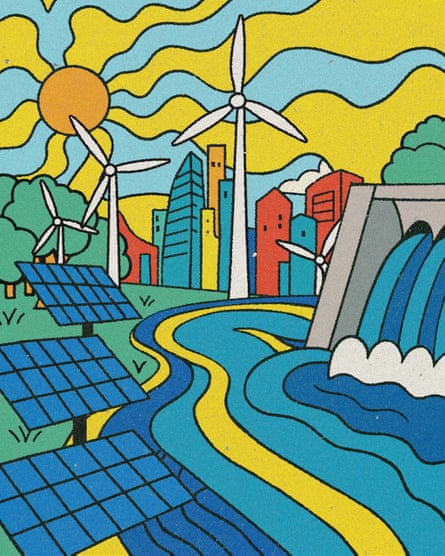

I know progressives are supposed to be technophobes, but there is one technology we probably love more than anyone else (except the engineers who created it): renewable energy. It is nothing less than astonishing and unbelievable that we have achieved so much progress in so little time.
At the turn of the century, sun and wind in the form of solar panels and wind turbines were expensive, primitive, utterly inadequate solutions to power our machines at scale, which is why early climate activism focused a lot on minimizing consumption on the assumption we had no real alternative to burning fossil fuels, but maybe we could burn less. This era did all too well in convincing people that if we did what the climate needs of us, we would be entering an era of austerity and renunciation, and it helped power the fossil fuel industry’s weaponization of climate footprints to make people think personal virtue in whittling down our consumption was the key thing.
There’s nothing wrong with being modest in your consumption, but the key thing to saving the planet is whittling down the fossil fuel industry and use of fossil fuels to almost nothing by making the energy transition to renewables and an electrified world. And that’s a transformation that has to be collective and not just individual.
Other stuff is great – changing our diets, especially to reduce beef consumption and food waste, protecting natural systems that sequester carbon, better urban design and better public transit, getting rid of fast fashion, excessive use of plastic, and other wasteful climate-harming forms of consumption – all matter. But the majority of climate change comes from burning fossil fuels, and we know exactly how to transition away from that and the transition is underway – not nearly fast enough, not nearly supported enough by most governments around the world, actively undermined by the Trump administration and many fossil fuel corporations and states.
But still, it is underway. And, arguably, unstoppable. Because it’s just a better way to do everything. One thing that’s been striking in recent years, and maybe visible in recent years because there is now an alternative, is the admission that fossil fuel is a wasteful and poisonous way to produce energy. That’s the case whether it’s to move a vehicle or cook a dinner.
Oil, coal, and gas are distributed unevenly around the world and just moving the fuel to the sites where it will be used is hugely energy inefficient. About 40% of global shipping is just moving fossil fuel around, and more fuel is moved on trains and trucks. But also, fossil fuel is extracted, shipped, refined for one purpose: to be burned, and in the future coming fast, burning is going to look like a primitive way to operate machines.
As the Rocky Mountain Institute explains it: “Today, most energy is wasted along the way. Out of the 606 EJ [exajoules] of primary energy that entered the global energy system in 2019, some 33% (196 EJ) was lost on the supply side due to energy production and transportation losses before it ever reached a consumer. Another 30% (183 EJ) was lost on the demand side turning final energy into useful energy. That means that of the 606 EJ we put into our energy system per annum, only 227 EJ ended up providing useful energy, like heating a home or moving a truck. That is only 37% efficient overall.” That’s the old system, and it’s dirty, toxic to human health and the environment – and our politics – as well as the main driver of climate chaos. And wasteful.
The new system, on the other hand, is far cleaner, and the fact that sun and wind are so widely available means that the corrosive politics of producer nations and their manipulations of dependent consumer nations could become a thing of the past. I know someone is about to pipe up with an objection about battery materials and there are two answers to that. One is that the race is on, with promising results, to produce batteries with more commonly available and widely distributed materials.
The other is that batteries are not like fossil fuel, which you incessantly burn up and have to replace; they are largely recyclable, and once the necessary material is gathered, it can be reused and extraction can wind down. But also the scale of materials needed for renewables is dwarfed by the materials to keep the fires burning in the fossil fuel economy (and the people who complain about extraction sometimes seem to forget about the monumental scale of fossil fuel extraction and all the forms of damage it generates, from Alberta to Nigeria to the Amazon).
And renewables are now adequate to meet almost all our needs, as experts like Australia’s Saul Griffiths and California’s Mark Z Jacobson have mapped out. Simply because it’s cheaper, better and ultimately more reliable, the transition is inevitable – but if we do it fast, we stabilize the climate and limit the destruction, and if we don’t, we don’t. Almost no one has summed up how huge the shifts are since the year 2000, but the Rocky Mountain Institute has done that for the last decade, during which, they tell us, “clean-tech costs have fallen by up to 80%, while investment is up nearly tenfold and solar generation has risen twelvefold. Electricity has become the largest source of useful energy, and the deep force of efficiency has reduced energy demand by a fifth.” Estimates for the future price of solar have almost always been overestimates; estimates for the implementation of solar have been underestimates.
Another hangover from early in the millennium is the idea that renewables are expensive. They were. They’re not anymore. There are costs involved in building new systems, of course, but solar power is now the cheapest way to produce electricity in most of the world, and there’s no sign that the plummet in costs is stopping. As Hannah Ritchie at Our World in Data said in 2021 of renewable energy, “In 2009, it was more than three times as expensive as coal. Now the script has flipped, and a new solar plant is almost three times cheaper than a new coal one. The price of electricity from solar declined by 89% between 2009 and 2019.”
But even cheap is a misnomer: wind and sun are free and inexhaustible; you just need devices to collect the energy and transform it into electricity (and transmission lines to distribute it). Free energy! We need to get people to recognize that is what’s on offer, along with energy independence – the real version, whereby if we do it right, we could build cooperatives, local (and hyperlocal or just autonomous individual) energy systems, thereby undermining predatory for-profit utilities companies as well as the fossil fuel industry. Renewable energy could be energy justice and energy democracy, as well as clean energy.
An energy revolution is underway in this century, though it’s unfolded in ways slow enough and technical enough for most people not to notice (and I assume it’s nowhere near finished). It is astonishing – a powerful solution to the climate crisis and the depredations of the fossil fuel industry and for-profit utilities. Making it more visible would make more people more enthused about it as a solution, a promise, a possibility we can, should, must pursue swiftly and wholeheartedly.
-
Rebecca Solnit is a Guardian US columnist. She is the author of No Straight Road Takes You There and Orwell’s Roses

 3 months ago
48
3 months ago
48

















































